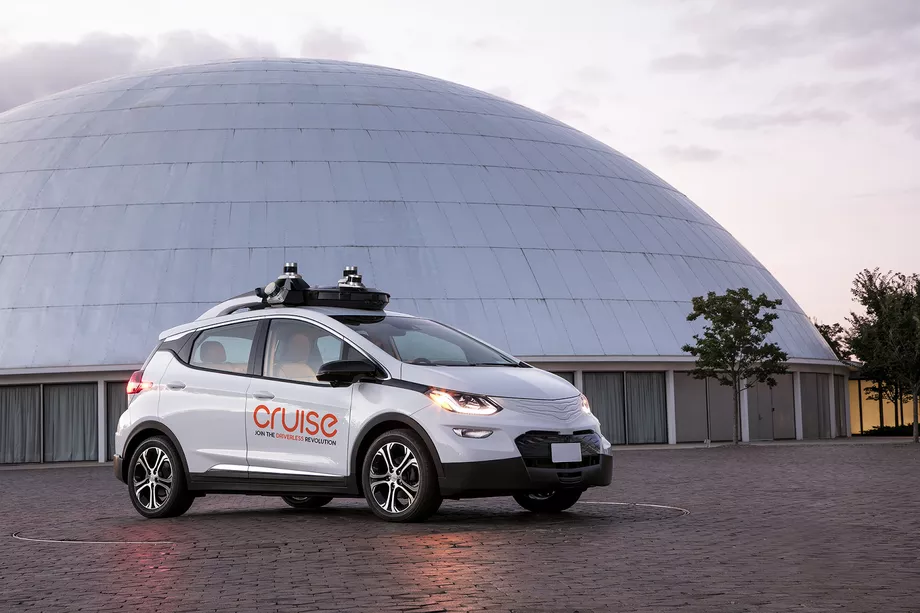Cruise’s production-ready autonomous car Cruise
The Chevy Bolt EVs will be built with the hardware necessary to enable fully self-driving cars.
General Motors and its self-driving subsidiary Cruise have started to build Chevy Bolt electric vehicles that are being produced with fully autonomous hardware. In other words, once the software is ready — perhaps within months — these third-generation Bolt EVs will be able to operate themselves completely without a driver.
GM is hardly the only company trying to build self-driving electric cars. But what sets it apart is its production capability to manufacture them at scale — something Tesla, say, currently lacks.
Today, most semi-autonomous cars that are operating on the streets of cities like Pittsburgh and San Francisco have the necessary radars and sensors essentially glued onto them after they come off the assembly line. Now, these Bolt EVs — of which approximately 50 have already been produced — will have all that hardware built in.
“When Cruise first started we quickly retrofitted the Chevy Bolt EV with our technology,” Cruise CEO Kyle Vogt said. “You’re bolting things on roofs and stripping wires and ripping out interior panels to run wires in the car. A lot of blood, sweat and tears go into those cars and it’s hard to keep them running. We’re on our third generation of the vehicle and this is the real deal.”
/cdn.vox-cdn.com/uploads/chorus_asset/file/9221147/0_xnDIRYcziGTBMnCg.png)
That means when GM and Cruise feel their software is ready to operate without a driver, GM can begin producing these cars at scale and deploy them.
“When we look at unlocking those benefits [of self-driving cars], it takes scale,” Vogt said on a press call.
Vogt wouldn’t give too many details about when he expected Cruise’s fully autonomous software to be ready to be tested on public roads but said that he anticipates it will be a matter of months, not years. It’s not clear when these cars will be commercialized.
In the coming weeks, the first few of these cars will be deployed in downtown San Francisco for employee use only. Staffers will be able to hail them using the in-house Cruise Anywhere app. Safety drivers and engineers will still be sitting behind the wheel ready to take over when needed.
This is a significant moment: Though the cars are still being produced in small numbers, it could give Cruise and GM a big advantage over its competitors. Many self-driving startups are just beginning to partner with automakers and have not yet made any public announcements about immediate plans to begin manufacturing fully integrated and production-ready self-driving cars.
In other words, even if Cruise and a competitor are able to develop their software to be fully self-driving at around the same time, Cruise might be able to deploy it en masse faster because GM is already ready to produce it.
While being the first to market with a fully self-driving car isn’t the end-all, be-all to competition within the space, it does give whoever is first the ability to test and validate its technology far longer and then update its software based on those learnings. That means, by the time the second player rolls out its fully self-driving cars onto public roads, the first one’s technology could already be far better.
“This kind of development requires full alignment, teamwork, rapid communication, and compromise between dozens of teams,” Vogt said in a blog post. “Since Cruise is a fully owned subsidiary of GM, we’ve avoided the seemingly impenetrable wall of politics, competitive fears, NDAs, liability concerns, data ownership, asset financing, long-term alignment, and a host of other issues that plague other relationships and partnership models.”
Tesla, for its part, announced earlier this year that its cars would be built with fully self-driving capabilities. That said, Tesla operates at a much smaller scale today than General Motors and Ford do.
“This [generation] is built with automotive-grade compliance across the board and is capable of going down a high-volume assembly line in one of GM’s state of the art facilities that can crank out hundreds of thousands of cars a year, and when those vehicles roll off the line they’re fully capable of operating without a driver.”
BY

